- Home
- About Us
- Join/Renew
- Member Benefits
- Member Pages
- Log In
- Help
- Museum Store
Hi, I need to remove the right-front shock to replace one of the front engine mount bolts. Before I break something, I want to confirm that the two bolt heads on the shock are the correct fasteners to remove. I think I am going to have to be rather firm with them, etc.
It’s a continuous soiree…
Randy, please post a photo !!
Are these Houdaille shocks? Round with two mounting ears ?
Or are these Lovejoy shocks: a cylinder mounted horizontally, parallel with the frame, the shaft that the shock’s lever is mounted on near the center of the cylinder. ??
The Lovejoy shocks usually have two studs threaded into the back or mounting side of the shock body. The two studs go through the frame, there is a rectangular stiffener with two holes that goes over the two studs. The two studs then have a lock washer and nut threaded on, and tightened very tight.
The access to the shock nuts is through a pair of holes in the inside of the frame. In this part of the frame, it is a box section, the inside vertical frame web is welded in.
You might have to modify an extension and socket to get on the shock nuts. There is minimal room to access the two mounting nuts.. And often there is headlight wiring exiting the front access hole. Be careful to not crush or damage the wiring..
A photo of the ‘bolts’ you mention will answer a lot of questions.
Greg Long
You are right; photos coming.
They are the Lovejoy shocks. There is one bolt with a nut and lock washer on the inside of the frame, very visible. It seems to pass through a casting or forging riveted to the inside of the frame, and this also seems to be the part which the front engine support bolts to. The two bolts pass through the part and one bolt head is too close to the shock body to remove without moving the shock. I cannot see the other bolt head, and I think it must be behind the shock.
By coincidence I just remounted Lovejoy shocks back onto my ’35 yesterday. I don’t know if you are having the same problem on your ’31 removing the shock, but for what it is worth: It was a bit tricky as mentioned. The hole to fit the socket through to turn the nut is slightly too small to fit a standard 15/16 socket. Maybe sockets were thinner back then. When I removed them a few years ago I wasted most of an afternoon looking for different sockets trying to find one slightly thinner. I didn’t find one. I ended up slowly cutting the OD down on a socket by grinding – I used a hand grinder to cut down a 1/2″ drive 15/16 standard socket mounted in a lathe.
It needs to be a standard socket – not a deep. A deep will stick out of the hole in the frame and bind when trying to turn because of the tight clearance after grinding down to the minimum possible to keep from weakening the socket too much.
Another trick when trying to reinstall is getting the split washer onto the stud without dropping it inside the channel. My fingers aren’t long or dexterous enough. I used a short length of brass tube the diameter of the stud to push against the stud while using a larger ID PVC pipe to push the split ring onto the stud. Mount the socket on a short extension, put the nut in the socket and use the extension to push the nut onto the stud and twist by hand to get it started. This was a surpizingly awkward task.
Good luck!
Jim
I made significant progress this afternoon. Turns out the shocks on my 1931 Series 43 are held on by two bolts which pass through holes in the shock body, rather than the blind studs some Lovejoys used. The front bolt has a nut readily accessible on the inside of the frame, no problem. The rear bolt also serves as the top bolt for the passenger-side engine mount; again with the nut to the inside and easily accessible.
After removing the nuts, both bolts were rusted tightly in place and would not budge. Liberal application of a 6-pound hammer to the poor sacrificial nut plus plenty of WD-40 and a 3-foot breaker bar and “leverage magnification device†(cheater pipe) and the front bolt finally gave up and came out. I have sprayed the tear bolt and moved it quite a bit; I am allowing it to soak for a while.
Thanks for the advice and help!
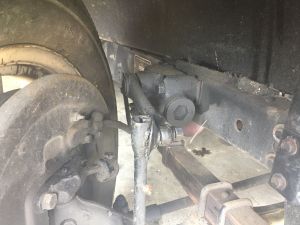
A photo of the passenger-side engine mount. The top bolt with the nut on is also the rear bolt holding the Lovejoy shock. The bottom bolt is the broken one that started all this work. Here I have welded a nut on it, thinking it was a broken stud. Surprise!
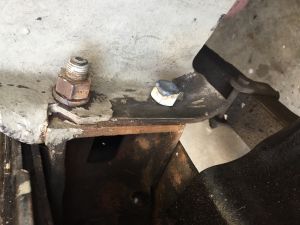
Peter, I do use PB Blaster and it’s good stuff; I picked up my can and it said “Pffft” so it was out. I also use AeroKroil, the favorite spray of the Solar Gas Turbine techs I encounter frequently in my professional life. My Granddad was an old-time auto and equipment mechanic and he called it all “PantherP!33”.
Got the bolts out, Lovejoy out of the way, etc. so now what to do? The three bolts involved are obviously purpose-made for the application, rather than something off-the-shelf. I will have to find a bolt to replace the broken one; the other two can be reused. I suspect they were originally fit into a reamed hole which got very tight with a little corrosion. The rust was otherwise not that extensive.
Randy, congrats on the progress made so far! There are quite a few locations on our Pierce’s that have a very good fit of fasteners, that were not protected by either paint or lubrication when the chassis was assembled. Water makes it’s way into every possible location, and finding naked, clean iron or steel, will inevitably create rust.
Thanks to your photo I now know what year Pierce the set of large Lovejoy shocks I have fit! These shocks have ‘through-bolt’ mounting bolts, and i didn’t know what they fit.
Regarding your broken engine mount bolt, please post a photo of one of the good ones and the broken one. With measurements for length and diameter. I have piles of fasteners. and I might find what you need.
The good news is I never throw anything away, the bad news is I never throw anything away !!!
Greg Long
Hi, Greg; I will get the photos of that bolt online. The broken one is not the one that passes through the Lovejoy, so it’s shorter at least.
I could always get a machinist to knock one out if we can’t come up with one; I’m thinking of 4140HT.
Replaced the broken bolt with a stock, Grade 5 bolt. Fit perfectly.
Now to tackle the other side, to see what we have there…
Well, well… the Gentle Giant (1931 Series 43) has a different-model shock on the right-front: it appears to be a spare retrieved from a car equipped with ride control. See photo for a comparison (the shock with the link attached is from the passenger-side).
The model numbers are: passenger side is 1650 F; driver side is 1652 PY and it has a ride control with the lever sawn off.
Because of the difficulty in removing the right-front unit, it could well be original and never removed, or at least not in a long time. I don’t understand the numbering system and I can’t yet determine what the correct shock is. There is a 1652 PY on Ebay being offered as a Packard shock.
There is some indication there is a right and left unit, and of course the front and rears are different, so if anyone can shed light on the correct shock for the 1931 Series 43 that will be a great help.
Another little blip: the shock on the passenger side has a steel shim between it and the frame. There is a rectangular steel pad welded to the frame on the driver side, very neatly, and the shock is bolted on here. The bolt pattern on both shocks is the same and the thickness of the shock body through which the mounting bolts pass is the same. I have no idea if the welded-on pad is original, or was added later. It is neat enough to be factory original, as far as appearance goes.
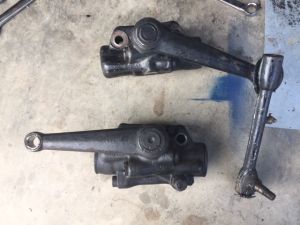
Ride control as far as I know started with the 1932 Pierce Arrow cars..
My Model 54 C.Coupe has ‘on the fly’ ride control with a lever on the right side of the dashboard.
BUT my ’32 Model 54 uses a shock with a threaded in stud for mounting to the frame.
I’m wondering if the larger, long wheelbase [heavier] 1932 cars got the style of shock you have, with
through-bolts for mounting to the frame.. ?
I have 4 Delco-Lovejoy shocks of your type, the through-bolt design. Two are 1650 G two are 1650 H .
Both have longer levers with a bend in the middle giving the arm a 15* or so kink. My ’32 has a long bent arm like this on the rear shocks.. Don’t know if that for sure makes these rear shocks or not.
Greg
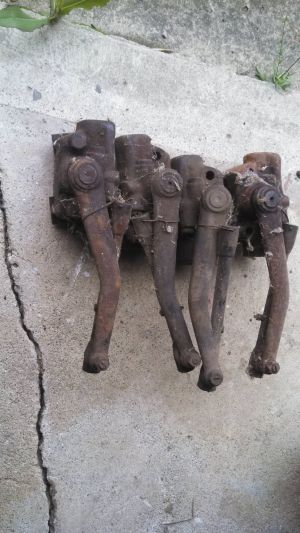
Greg, I don’t understand the numbering system, but “1650” is promising at least. The right-hand shocks will have the arm pointing to the right with the two mounting holes at the top; the left (driver’s side) will have the lever arm pointing to the left with the holes on top.
The front arms on my car are straight; I have not looked at the rear shocks yet.
Correction to my earlier post: the oddball shock is on the driver’s side; the shock 1650 F which I think may be correct, is on the passenger side. I used a confusing mix of right-left as I was facing the Car’s front, vs. the reality that the left of the Car is in fact the driver’s side.
New information: I gleaned this chassis photo of a 1931 Series 43 from the internet this afternoon. It clearly shows the steel shim underneath the shock on the passenger-front side, exactly as I found on my Car. Note the folded end of the shim on the forward end, presumably this aligns the shock perpendicular to the front axle and makes up for the taper of the frame rail.
I would like to see the other side, but alas! it was not available. I am curious about that steel pad welded to my
Car’s frame on the driver’s side.
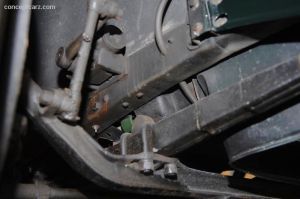
It occurred to me that the difference between the left and right shock on an axle would be jouncevand rebound swap. Perhaps one can swap the two valves in the shock plus the lever arm, to accomplish this. Not certain though.
I have learned from the helpful folks at Apple Hydraulics that the correct shoks for the front of the 1931 Series 43 is: right= 1650 F; left=1650 E. The shock on the driver’s side of my Car is from the rear of a ‘32-‘34 Packard. Now I know what I’m looking for!
Greg yours may be rear shocks. The fronts have a straight arm. I haven’t put eyes on my Car’s rear shocks yet.
